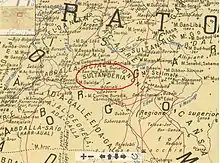Deria Hassan
Sultan Deria Hassan (Somali: Diiriye Xasan) was a Somali ruler. He was the fourth Grand Sultan of the Isaaq and known as a shrewd and wise leader.[1]
| Sultan Deria Hassan سلطان ديريه حسن | |
|---|---|
| 4th Grand Sultan of the Isaaq | |
| Reign | 1870 - 1939 |
| Predecessor | Hassan Farah |
| Successor | Abdillahi Deria |
| Dynasty | Guled Dynasty |
| Religion | Sunni Islam |
Biography
Deria was the son of Sultan Hassan and the great grandson of Sultan Guled, the founder of the Guled Dynasty of the Eidagale clan. He belonged the Ba Ambaro section of the Guled family.[2] Deria was the longest reigning Sultan having ascended to the throne in the late 19th century and dying of old age in the late 1930s, where he was succeeded by his eldest son, Abdilahi.[3] Deria also regularly exacted tribute from the Isaaq sub-clans.[4] Deria would meet with Sheikh Madar outside Hargeisa in a famous 1870 shir to discuss issues regarding the new town of Hargeisa and agreed that poaching and tree cutting in the vicinity should be banned.[5]

Reign
As Sultan of Isaaq, he also was the paramount leader of his Eidagale clan and tensions were high between his Rer Guled and another subclan of Eidagale. The legendary Eidagale warrior & poet Hussein Hasan Somali: Xuseen Xassan who hailed from the Rer Guled was prideful and urged them to continue the conflict. Standing against him was a similarly skilled poet & warrior Hersi Absiyeh Somali: Xirsi Cabsiye a prominent member of the closely related Rer Abdi Bari who were warring with the Rer Guled. He called for the regular shir or meeting of subclans where he would take council and advise on what decisions to make next for the Eidagale. Sultan Deria ruled that blood payment or mag was sufficient for both parties to exchange at the shir with the Rer Guled losing six and the Abdi Bari six as well. Hussein Hasan was boastful and urged for continued conflict with this rousing gabay rejecting the decision.[6]
Lix nin oo mankiyo shaalka iyo midhaha Guuleed ah |
Six men who are the buds, the shawl and the fruit (youth) of Guuleed |
| —Xuseen Xasan[7] |
Sultan Deria responded by sending Hussein away to Berbera and then resuming the shir. Absiyeh was made to swear a solemn oath not to recite a gabay following the Sultan's decision but he could not resist, especially since Hussein was away. Hussein returned and lamented that he missed the occasion and the two other men (Deria & Absiyeh) prevailed that day.[8]
Dervish Era
In the year 1899, Sultan Deria Hassan received one of the earliest letters sent by Muhammad Abdullah Hassan to garner support for the then fledgling Dervish Movement. This shows how influential Sultan Deria was in the Somali north since he was earnestly implored by the Mullah to join him in his endeavors.
I have the honour to enclose a translation of a letter from the Mullah Muhammad Abdullah to the Aidagalleh, as a specimen of the manner in which he has been trying to seduce the tribes from their allegiance to us. Although this letter has only come into my hands there is reason to believe that it reached Sultan Deria of the Aidagalleh some two months ago, for the Sheikh Madar tells me that about that time Sultan Deria sent a message to him saying that he had heard from the Mullah and asking his advice as to whether he should join him or not.[9]
It appears that Deria heeded the call for support as the Sultan instigated a major insurrection in the town of Hargeisa as well as supplying Abdullah Hassan with vital information.
Lieutenant Byrne reports to me that Sultan Deria is the principal cause of unrest around Hargaisa. He is in communication with the Mullah, supplying him with information and giving every assistance prior to joining him himself.[10]
Rebellions
Deria's reign saw a some Instability and revolts that were swiftly contained. Swayne recounts and incident where a portion of the Eidagale broke away, but were quickly brought to heel.
The late Assistant Resident at Berbera had a case brought before him in which a part of the Eidegalla tribe had thrown off allegiance to Sultan Deria, and when his intervention was successful, one of the terms proposed by the delinquents themselves was that they would diballtig before him as a recognition of their return to his control.
See also
- Somali aristocratic and court titles
- Garhajis
- Hussein Hasan poet & warrior
- Nur Ahmed Aman contemporary of Sultan Deria Hassan and Sultan of the Habr Yunis
- Abdillahi Deria the son & successor of Sultan Deria Hassan
- Farah Nur
- Isaaq
References
- Orwin, Martin; Axmed, Rashiid (2009). War and Peace: An anthology of Somali literature Suugaanta Nabadda iyo Colaadda. Progressio. p. 209. ISBN 9781852873295.
- Carlos-Swayne, Harald. Seventeen Trips Through Somaliland and a Visit to Abyssinia: with supplementary preface on the 'Mad Mullah' risings. pp. 15–20.
- TRIBES OF BRITISH SOMALILAND, 1941, p. 6
- Andrzejewski, B. W. (1985). Literatures in African Languages: Theoretical Issues and Sample Surveys. Cambridge University Press. p. 346.
- WSP Transition Programme, War-torn Societies Project (2005). Rebuilding Somaliland: Issues and Possibilities, Volume 1. Red Sea Press. p. 214.
- Orwin, Martin; Axmed, Rashiid (2009). War and Peace: An anthology of Somali literature Suugaanta Nabadda iyo Colaadda. Progressio. p. 209. ISBN 9781852873295.
- War and Peace: An Anthology of Somali literature, p.210
- Orwin, Martin; Axmed, Rashiid (2009). War and Peace: An anthology of Somali literature Suugaanta Nabadda iyo Colaadda. Progressio. p. 209. ISBN 9781852873295.
- F.O.78/5031, Sayyid Mohamad To The Aidagalleh, Enclosed Sadler To Salisbury. 69, 20 August 1899
- Parliamentary Papers: 1850-1908, Volume 48. H.M. Stationery Office. 1901. p. 65.